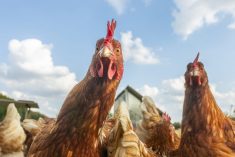Imports of horse semen and embryos from the U.S. will now need more paperwork as Ottawa looks to keep a horse venereal disease out of Canada.
The Canadian Food Inspection Agency’s (CFIA) new requirements, announced Tuesday, follow an earlier tightening of restrictions Jan. 23 on imports of live U.S. horses and related animals.
CFIA found before Christmas that farms in Ontario and Alberta received semen last spring taken from one of three Kentucky stallions that have since tested positive for contagious equine metritis (CEM).
Read Also

U.S. livestock: Cattle strength continues
Cattle futures on the Chicago Mercantile Exchange were stronger on Friday, hitting fresh highs to end the week.
The new requirements are a “precautionary response” to the recent outbreak of CEM in the U.S.
The new rules for semen imports, both fresh and frozen, take effect retroactive to Jan. 29. An import permit and U.S. veterinary health certificate are required, documenting that the donor stallion has not been on property where T. equigenitalis, the bacteria that causes CEM, has been isolated during the 60 days before the semen was collected for export. The same goes for semen collected on properties either under quarantine or investigation for CEM.
Imported semen must also have been processed using an extender that contains antibiotics effective against T. equigenitalis, CFIA said. It must also be shipped in individual receptacles or straws, each marked with the collection date, identity of the donor and the semen collection premises.
Embryos, as well, will need an import permit and U.S. veterinary health certificate verifying that the donor mare hadn’t been on any property where the CEM bacteria had been isolated in the previous 60 days before embryo collection.
The donor mare for imported embryos also must not have been bred, either naturally or by artificial insemination, with semen from a CEM-positive stallion or a stallion from a property that’s either CEM-positive or under quarantine or investigation for CEM.
Embryos must also have been flushed using a medium containing antibiotics effective against CEM bacteria, and must be shipped in sterile straws or pipettes, each marked with the collection date, identity of the donor and the embryo collection premises.
Canadian horse breeders looking to import semen or embryos will need to contact their local CFIA area offices to get the necessary import permit applications.
Exposed horses
The U.S. Department of Agriculture’s Animal and Plant Health Inspection Service (APHIS) reports on its website that a total of 11 stallions in Kentucky, Texas, Indiana and Wisconsin have now tested positive for CEM, as has one mare in Wisconsin.
The infected Wisconsin mare was bred by live cover to one of the CEM-positive stallions in Wisconsin, just prior to it becoming known that the stallion had been exposed to CEM, APHIS said.
APHIS has also confirmed the locations of 512 other CEM-exposed horses for a total of 59 stallions and 465 mares in 45 states. Another 25 CEM-exposed mares are “still actively being traced.”
According to APHIS, clinical signs of CEM can include a vaginal discharge in up to 40 per cent of affected mares, as well as abortion and infertility. Stallions typically show no clinical signs.
Stallions and mares can become chronic carriers of CEM and be sources of infection for future outbreaks. The transmission rate is high and naturally occurs by mating, but contaminated instruments and equipment may be an indirect source of infecting mares and stallions. CEM bacteria can also be spread by way of semen collected for artificial insemination, APHIS said.















